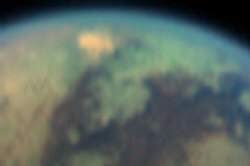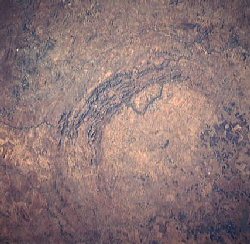|
SpaceTides
Newsletter # 31 - May 2005
Internet
Newsletter of ASSA Bloemfontein Centre,
South Africa, to the public
www.assabfn.co.za/spacetides
|
In this issue of SpaceTides
|
INDEX: Issue #31
1. Spaceflight news from around the world
2. Astronomy news from around the world
3. Interesting space facts
4. Space questions
5. Web links
6. Astronomy news in South Africa
7. Astronomy events in the City of Bloemfontein
Dear SpaceTides subscribers
If you are in a hurry
with little time to read through the whole newsletter: at the top of the
news sections, you
will find a short summary of each piece's central theme.
Under the Net nodes section, you will find all kinds of web related
news and sometimes even useless nonsense.
Just to bring in a bit of balance.
And for the record (and for you conspiracy buffs out there), no hidden
code can be found by reading a SpaceTides
newsletter upside down, from right to left, holding the text by candle
light, or smearing it with lemon/litchi juice. Really...
Please forward the newsletter to your friends and colleagues. Note that
SpaceTides accepts no liability for lost
productivity at work ;)
Gerrit
Penning
Editor
Total subscribers as at 26 May 2005: 118
|
1. Spaceflight news from around the world
|
Spaceflight
in short:
- "Voyager Spacecraft Enters Solar System's Final Frontier"
- The probe
has crossed the termination shock
and entered the "heliosheath" 14 billion km away - December
2004.
-
Return to Flight: The next Space Shuttle mission rolling out... - launch slated for 13
July 2005 to the ISS.
|

Image credit: NASA/JPL
|
"Voyager
Spacecraft Enters Solar System's Final Frontier"
From
NASA/JPL News release, May 24 2005
Read the full article at: www.jpl.nasa.gov/news/news.cfm?release=2005-084
The
Voyager 1 space probe, launched in 1977, arrived at Jupiter in 1979
and went on to visit Saturn in 1980. Already far past the orbit
of Pluto, Voyager 1 has now entered a region of the far outer solar
system, where the magnetic field intensifies and the solar wind
is drastically slowed and becomes super-heated. The probe crossed
what is known as the "termination shock" during December
16, 2004, and entered the "heliosheath" - an unchartered
region of the outer solar system. It takes data 13 hours to travel
the 14 billion kilometers to Earth from Voyager 1.
|
|

Image credit: NASA/JPL
|
Return to Flight: The next Space Shuttle mission rolling out...
www.nasa.gov/returntoflight/main/index.html
The
last shuttle flight took place in late January 2003. Shuttle Columbia
met a tragic fate upon re-entry into the atmosphere. But shuttle
flights are about to resume: at NASA's Kennedy Space Centre in Florida,
preparations are made to roll out Space Shuttle Discovery to the
"Vehicle Assembly Building" on Thursday, May 26. Launch
is slated for July 13, 2005. Discovery has completed 30 missions
so far. The July mission will consist of delivering supplies to
the International Space Station and making repairs.
|
|
2. Astronomy news from around the world
|
Astronomy in short:
- Strange red spot on Saturn's moon Titan: The Cassini spacecraft observed an
area on Titan showing a large
reddish spot, with still no exact explanation for its prominence.
- Gravitational microlensing technique used to find exoplanet: Astronomers
successfully used the microlensing
effect to discover an exoplanet circling a star 15 000 light years away.
|

Image credit: NASA/JPL
|
Strange
red spot on Saturn's moon Titan:
May
25, 2005. Read full article at:
www.jpl.nasa.gov/news/news.cfm?release=2005-086
When
the Cassini spacecraft flew by Saturn's largest moon Titan on March
31 and April 16 2005, its visual and infrared mapping spectrometer
observed an intriguing red spot, the brightest area ever observed
on Titan. According to the JPL article, the 483-kilometer-wide region
"may be a "hot" spot - an area possibly warmed by
a recent asteroid impact or by a mixture of water ice and ammonia
from a warm interior, oozing out of an ice volcano onto colder surrounding
terrain. Other possibilities for the unusual bright spot include
landscape features holding clouds in place or unusual materials
on the surface".
|
|

Image credit: Optical Gravitational Lensing Experiment
|
Gravitational
microlensing technique used to find exoplanet
May
23, 2005. Read full article at: http://cfa-www.harvard.edu/press/pr0514.html
Amateur
and professional astronomers teamed up to discover a new planet
circling a star 15 000 light years away (called an "exoplanet").
It was discovered by using the effect that the planet's gravitational
field had on the light from a more distant star "behind it"
- a technique known as microlensing. It is the 2nd
exoplanet to be discovered using the microlensing technique. (In
total, about 130 exoplanets have thus far been found since the first
one was detected about 10 years ago, but all are mostly giant Jupiter-like
gas planets).
Astronomers
discovered the exoplanet when it and its star crossed in front of
a faint background star (marked by crosshairs left). The background
star's light was magnified by the foreground star in a process called
gravitational microlensing. The planet is 3 times
the size of Jupiter, and 10 Earths can fit into the diameter of
Jupiter alone!
|
|
3. Interesting Space Facts
|
- One cosmic
year is the time the sun takes to make one orbit around the centre
of our Milky Way
Galaxy: 225 million years. Though it sounds slow, it IS a free ride
through space!
- You can find the highest mountain in the solar system on Mars.
Olympus Mons, 26 km high, is an extinct volcano,
and almost 3 times higher than Mt. Everest. Good luck to our first hiker!
Send us a pic.
- During a lunar
eclipse, you can see the curved shape of the Earth's shadow. This
is naked eye, no-jokes,
groundbased evidence that the Earth is indeed round! I'm going to say
up my membership at the Flat Earth Society.
|

Credit: NASA
|
What
will happen if the Earth suddenly stops spinning?
More
information:
http://starryskies.com/articles/2003/09/earth.rotation.html
Most people
think that the everything and everyone will just slowly drift off
into space when the Earth stops spinning. Well, that's just not
the case! If our planet suddenly comes to a halt, everything not
very firmly fixed will simply "keep on moving" at the
Earth's usual rotation speed of 1 600 km/h. That is, until you hit
something at that speed! Cars, trees, houses, loose rocks,
(you!), everything will be swept away along the surface and into
the atmosphere. Gravity does not give rise to the spinning effect.
I better find myself a home somewhere on a koppie in the Karoo...
|
|
 Credit:
NASA JSC Credit:
NASA JSC
|
Where
in South Africa will you find one of the oldest and largest known
impact craters in the world?
More
information: www.hartrao.ac.za/other/vredefort/vredefort.html
Near the town of Vredefort in the Free State Province, South Africa.
The Vredefort Crater was always believed to be of volcanic
origin, but recent studies deem it a meteorite crater of 300 km
wide, made by a 2 km sized rock which hit the Earth about 2.1 billion
years ago. Though not all remains are visually discernable from the
surface, satellite pictures clearly show an arc. Interestingly enough
(and not coincidentally), many of South
Africa 's gold mines is situated
on the rim of the old crater...
|
Other astronomy and spaceflight subscription services
offering free e-mail newsletters (and these are some of the
best on the internet) can be found at:
- Sky and Telescope: http://skyandtelescope.com/shopatsky/emailsubscribe.asp
- Spaceflightnow: www.spaceflightnow.com
- Universe today: www.universetoday.com
- Earth and Moon
Viewer: No doubt a great inter-active website.
See photo's of how the Earth looks from space,
at any time of the day: www.fourmilab.ch/earthview/vplanet.html
|
6. Astronomy News in South Africa
|
|

Credit:
SAAO / SALT
|
All 91 segments of SALT's primary mirror installed
All information
from the SALT website, at www.salt.ac.za/content/news/default.htm
< "The last of the 91 mirror segments has been inserted
into the 11-metre primary mirror array of the Southern African Large
Telescope (SALT). Each mirror segment is 1 metre wide and weighs
approximately 100 kilograms. Construction on SALT started
in 2000 and the first mirror segment was installed in December 2003.
The completion of SALT's primary mirror is a significant milestone
in the construction of this telescope. SALT will commence operation
later this year".
Visit the
official SALT website at:
www.salt.ac.za
|
For
other SA Astronomy websites, go to the SpaceTides SA Astronomy
Portal at:
http://www.assabfn.co.za/spacetides/sa_astronomy.htm
|
7. Astronomy Events in Bloemfontein
|
There
are various astronomy organizations and entities in the City of Bloemfontein.
The Bloemfontein area boasts
excellent sky conditions - near-perfect for the amateur and professional
astronomer or casual observer alike.
Winter provides clear, crisp and dry weather conditions. You are
welcome to visit the following websites:
Explore Boyden Observatory: www.assabfn.co.za/friendsofboyden/explore.htm
One of the most publicly accessible observatories of its kind in the
Southern Hemisphere, also housing SA's third
largest telescope.
The Friends of Boyden: www.assabfn.co.za/friendsofboyden
A public interest group for Boyden Observatory and for people interested
in joining the astronomy community of
Bloemfontein, but not make astronomy their "full-time" hobby.
The next meeting is on 11 June 2005, when the
Friends will receive a digital presentation on the Deep Impact Mission
to a comet. See contact number below.
ASSA Bloemfontein Centre: www.assabfn.co.za
Affiliated with the Astronomical Society of Southern Africa, the Bloemfontein
Centre of ASSA is an active organization
of amateur astronomers meeting on a regular basis to discuss and practise
astronomy. The next meeting is on
28 May 2005 - contact 084 429 9080 for more information or send an e-mail
to mail@assabfn.co.za.
Onthou ook om Boyden Sterrewag se gereelde sterrekunde berigte in die
"Ons Stad" plaaslike koerant te lees. Dit bevat ook meer inligting
rondom Boyden besoektye.
SpaceTides is a free internet e-zine for persons interested in expanding their
general knowledge of astronomy and spaceflight.
The e-zine originates from the City of Bloemfontein in South Africa and
is compiled us a service to the public by ASSA Bloemfontein Centre
as part of their educational outreach activities. Website: www.assabfn.co.za.
SpaceTides contains links to various other third party sites on the
internet, not always connected to SpaceTides. The persons and entities
responsible
for compiling SpaceTides will not be held responsible for the content
or information on these third party sites or any damage of any kind
incurred from
downloading, opening, or viewing anything from/through these sites.
If you would like to unsubscribe from SpaceTides, send an e-mail
to spacetides@assabfn.co.za with the word
"Unsubscribe" in the subject line.
|



